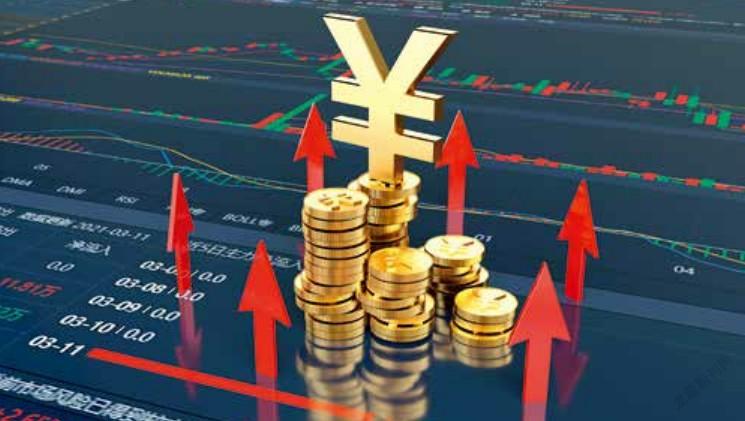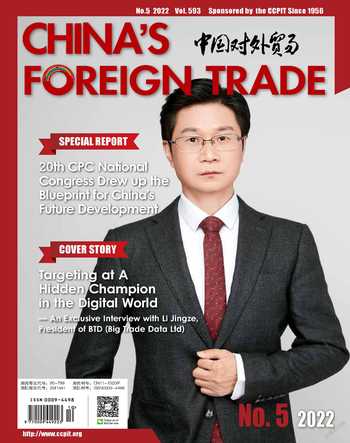Cross-border Use of RMB Has Steadily Increased
By Lily Wang

According to the latest RMB Internationalization Report 2022 issued by the Peoples Bank of China, the international payment share of RMB increased to 2.7% in December 2021, surpassing the yen to become the fourth mostused payment currency in the world, and then further increased to 3.2% in January 2022, a record high.
The Society for Worldwide Interbank Financial Telecommunications(SWIFT) RMB tracking indicator also shows that the proportion of RMB transactions in August increased from 2.20% in July to 2.31%.
Cross-border settlement related to the real economy has grown rapidly
SWIFTs tracking indicator shows that in August, the amount of US dollar transactions increased from 41.19% in the previous month to 42.63%, ranking first. That month, the use of the euro dropped from 35.49% in the previous month to 34.49%. Moreover, the proportion of pounds used remained at the level of 6.45% seen in the previous month. The yen was 2.73%, compared with 2.82% in the previous month.
On September 23, Russian media also reported that the August statistics released by SWIFT in September showed that the offshore RMB payment scale in Russia ranked third in the world.
Among the 15 economies with the largest number of offshore RMB payments, Russia ranks third, accounting for 4.3% of the total. Analysts of the company pointed out that Britain(5.75%) and Hong Kong (71.14%) still ranked ahead of it. Singapore and the United States ranked fourth and fifth, with 3.77% and 2.98% respectively.
The RMB is also being used as a reserve currency by more and more countries. With geopolitical conflicts likely to weaken the dominant position of the U.S. dollar, central banks in various countries have begun to seek to diversify their foreign exchange reserves with RMB.
According to the RMB Internationalization Report 2022, cross-border RMB settlement related to the real economy has maintained a rapid growth, with commodities, cross-border e-commerce and other fields becoming new growth points, and cross-border two-way investment activities continuing to be active. The RMB exchange rate generally shows a two-way fluctuation trend, and the endogenous demand of market participants to use RMB to avoid exchange rate risks is gradually increasing. Basic systems such as RMB cross-border investment and financing, transaction settlement and so on have been continuously improved, and the ability to serve the real economy has been continuously enhanced.
The opening of Chinas financial market continues to advance, and RMB assets remain highly attractive to global investors. By the end of 2021, the total amount of domestic RMB stocks, bonds, loans and deposits held by overseas entities was RMB 10.83 trillion, a year-on-year increase of 20.5%. The offshore RMB market is gradually warming up and trading is becoming more active. By the end of 2021, RMB deposits in major offshore markets accounted for close to RMB 1.50 trillion.
Continuous optimization of RMB settlement environment for cross-border trade and investment
Cross-border trade settlement based on current accounts has always been the basic driving force behind RMB internationalization. In recent years, exchange rate fluctuations have increased, making more and more enterprises realize the importance of exchange rate hedging and local currency settlement. For foreign-funded enterprises, the use of RMB in cross-border trade and investment can reduce the exchange rate risk and exchange costs. Local currency settlement is more convenient and cheaper than any exchange rate hedging tool.
Steadily carrying out the pilot project of RMB settlement facilitation for trade and investment at a higher level, and encouraging banks to include more high-quality SMEs in the facilitation policy; supporting banks“enterprise-based policies” to meet the exchange rate hedging needs of foreign trade enterprises; providing cross-border RMB settlement services under current accounts for market transaction entities and individuals such as cross-border electronic commerce and overseas ware-houses; banks being encouraged to simplify the settlement process and provide high-quality enterprises with convenient and efficient cross-border RMB investment and financing services, etc., are all coming into play. Since this year, the Peoples Bank of China has continuously optimized the RMB settlement environment for cross-border trade and investment. Zhou Maohua, a researcher in the financial market department of Everbright Bank, believes that focusing on the needs of the real economy and promoting, in line with the principle of macro-prudential management of cross-border capital flows, the facilitation level of cross-border use of RMB to a new level will help promote the two-way opening-up of high-level trade and investment and financing, improve the internationalization level of the RMB, and better serve the real economy.
The data shows that from January to June this year, RMB settlement business of cross-border trade totaled RMB 4.58 trillion, and the RMB settlement business of direct investment was RMB 3.01 trillion, compared with RMB 3.6 trillion and RMB 2.54 trillion in the same period last year.
Increasing mobility is the key
Zhou Tianyun, a professor at the International School of Business and Finance of Sun Yat-sen University and a researcher at the Advanced Institute of Finance, believes that the mobility of RMB assets is the property of RMB assets that investors are most concerned about. Therefore, improving the mobility of RMB assets has become the trend and direction in which to promote the internationalization of RMB.
Zhou Tianyun explained that institutional opening promotes the two-way opening of higher-level financial markets, and the financial market has changed from a partial pipeline opening to a comprehensive institutional opening. The two-way opening covering all markets, institutions and products is expected to be steadily expanded, and the interconnection between domestic and foreign markets is also expected to be continuously deepened. Under the conditions of opening-up, the regulatory capacity is expected to be continuously strengthened, and the dividends of opening-up will be further released. The continuous promotion of the opening-up of Chinas financial market has laid a market foundation determined by the RMB exchange rate market, promoted the benign interaction between the onshore and offshore RMB markets, kept RMB assets attractive to global investors, and continued to strengthen the status of the RMB as an international currency.“At present, Chinas economic fundamentals are stable, its opening direction is firm, and it is only limited by external factors. The underlying logic behind foreign investment in RMB assets has not changed.”
Secondly, the developed financial market provides the necessary environment and platform for RMB internationalization. When the RMB becomes an international currency, it must perform the functions of exchange and payment in the developed financial market. Without a perfect financial market, the internationalization of the RMB will lack the foundation for promotion. “Diversified financial products in the financial market, an active secondary market and a high mobility are the market basis for promoting the internationalization of the RMB, and helping to speed up the process of RMB internationalization,” said Zhou Tianzhu.
Thirdly, the increasing liquidity of RMB financial assets encourages foreign investors to invest in the Chinese market, enriches the types of investable assets, and helps foreign investors, especially central banking institutions, to allocate more RMB assets. The cross-border RMB receipts and payments under securities investments generally show a net inflow, which helps to enhance the status of the RMB as an international investment and financing currency. By the end of 2021, the total amount of domestic RMB stocks, bonds, loans and deposits held by overseas entities was RMB 10.83 trillion, a year-on-year increase of 20.5%. The offshore RMB market is gradually warming up and trading is becoming more active. By the end of 2021, RMB deposits in major offshore markets were close to RMB 1.50 trillion.
With the expansion of the financial market scale and the improvement in the efficiency, more RMB settlement and financing will be conducted through the financial market, thus enhancing the status of the RMB as an international currency. Zhou Tianyun believes that a financial market with a large capacity and many local currency-denominated financial products, as well as standardized and international operating rules and market order, can not only provide lowcost services for international asset transfer and capital flow to attract local currency-denominated assets that non-residents are willing to hold, but also provides a sufficient quantity and a highly mobile trading market for RMB-denominated financial assets, thus meeting overseas demands for reserve assets.
- China’s foreign Trade的其它文章
- Targeting at A Hidden Champion in the Digital World
- China(Xinjiang)-Kazakhstan Entrepreneurs Forum Held
- 20th CPC National Congress Drew Up the Blueprint for China’s Future Development
- RCEP Continues to Expand Its Effects
- BCG to Boost Thailand’s Economic Recovery and Sets the Tone for China Thailand Cooperation
- The Resumption of Diplomatic Relations Between China and Nicaragua Signals A Move Forward Side by Side

